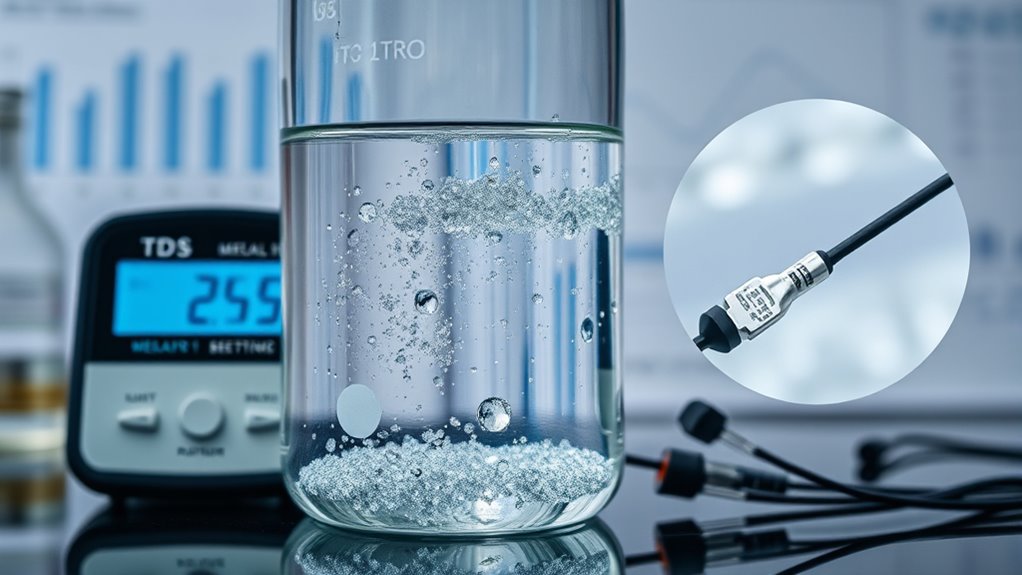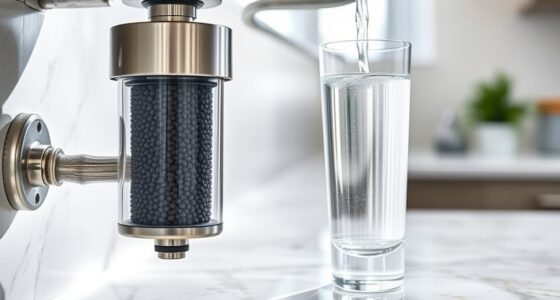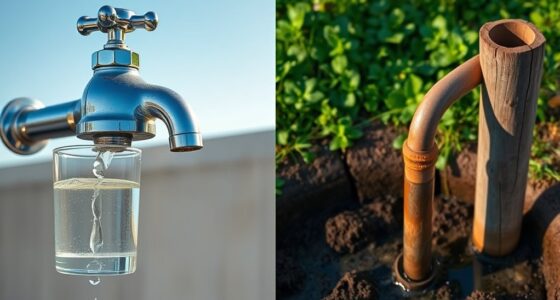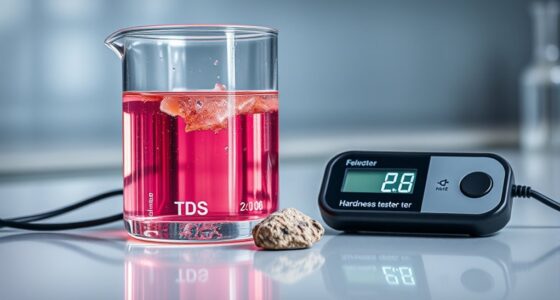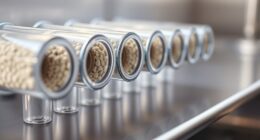Total Dissolved Solids (TDS) refer to minerals, salts, metals, and organic substances dissolved in water, which can affect its taste, safety, and overall quality. High TDS levels might make water taste unpleasant, cause pipe scaling, or harm appliances, but don’t always signify water is unsafe. Knowing your TDS level helps you choose the right water treatment method and ensure clean, good-tasting water. If you’re curious, there’s more to discover about managing TDS effectively.
Key Takeaways
- TDS refers to minerals, salts, metals, and organic substances dissolved in water, affecting its quality and safety.
- Measuring TDS helps determine water purity, with levels below 300 mg/L generally safe for drinking.
- High TDS can cause taste issues, pipe scaling, and reduce appliance efficiency, but doesn’t always indicate unsafe water.
- TDS measurement techniques include portable meters assessing electrical conductivity and laboratory analysis for detailed results.
- Proper understanding of TDS levels guides effective water treatment, ensuring clean, safe, and palatable drinking water.
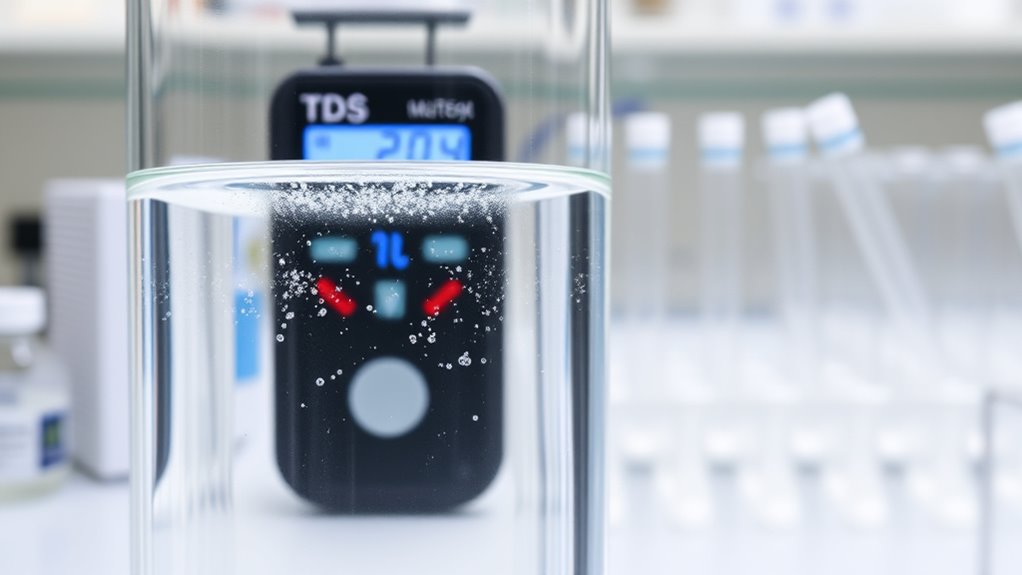
Have you ever wondered what’s in your drinking water beyond just the visible? It’s easy to assume that clear, odorless water is pure, but in reality, it contains a range of dissolved solids that you can’t see. These total dissolved solids, or TDS, include minerals, salts, metals, and other organic and inorganic substances. While some of these are beneficial, like calcium and magnesium, others can be harmful or affect water’s taste and safety. Understanding TDS and how it’s measured is vital if you want to guarantee your water is safe and of good quality. Proper water testing techniques are essential for accurate assessment and ensuring your water meets health standards.
Water purification plays an essential role in managing TDS levels. Different filtration systems, like reverse osmosis, distillation, or activated carbon filters, target specific contaminants and dissolved solids to improve water quality. For example, reverse osmosis systems are highly effective at reducing TDS because they force water through a semi-permeable membrane, stripping away a significant portion of dissolved solids. But before choosing a purification method, it’s important to know your water’s existing TDS level. That’s where TDS measurement techniques come into play. These techniques allow you to quickly and accurately determine the concentration of dissolved solids in your water sample.
Effective water purification requires knowing your TDS level before choosing the right filtration system.
One common method is using a TDS meter, a portable device that provides instant readings. It works by passing a small electrical current through the water and measuring the electrical conductivity, which correlates with the amount of dissolved solids. The higher the conductivity, the higher the TDS. This method is simple, cost-effective, and highly practical for everyday use. Alternatively, more detailed laboratory analysis can be conducted for precise results, especially if you’re dealing with specific contaminants like heavy metals or organic compounds. These tests often involve advanced techniques such as ion chromatography or atomic absorption spectroscopy, which provide a complete understanding of what’s dissolved in your water.
Knowing your TDS level helps you decide whether your water needs treatment or further purification. For instance, a TDS reading below 300 mg/L is generally considered good for drinking water, while readings above 500 mg/L might indicate the need for filtration. High TDS doesn’t always mean water is unsafe, but it can impact taste, cause scaling in pipes, or reduce the efficiency of appliances. By understanding water purification options and utilizing proper TDS measurement techniques, you can take control of your water quality and guarantee it’s safe, clean, and pleasant to drink.
Frequently Asked Questions
How Does TDS Affect the Taste of Drinking Water?
Higher TDS levels can make your drinking water taste metallic, salty, or bitter, affecting your overall flavor experience. When TDS is balanced with the right mineral content, it can enhance the flavor, making your water more invigorating. Too low or too high TDS disrupts this balance, leading to flat or unpleasant tastes. You’ll notice that proper mineral content in water improves taste, while excess dissolved solids can detract from it.
Can High TDS Levels Cause Health Issues?
You might not realize it, but high TDS levels can impact your health, especially if contaminants like heavy metals are present. Poor water quality with elevated TDS may lead to health issues such as gastrointestinal problems or long-term risks like kidney damage. Always monitor your water’s TDS to guarantee it’s within safe limits, protecting both your health implications and overall water quality. Stay informed and keep your water safe.
What Are Common Sources of TDS in Water?
You find common sources of TDS in water through mineral leaching from rocks and soil, which releases minerals like calcium, magnesium, and sodium. Agricultural runoff also contributes considerably, carrying fertilizers, pesticides, and organic matter into water sources. These processes increase TDS levels, affecting water quality. To manage this, consider testing your water regularly and implementing filtration systems that target specific dissolved solids for safer drinking water.
How Often Should TDS Levels Be Tested?
You should test your water’s TDS levels regularly, ideally every three to six months, to guarantee safety and quality. Establish a consistent TDS monitoring schedule that aligns with your water source and usage. Water testing frequency depends on factors like source changes, environmental conditions, or after treatment processes. Staying vigilant with periodic testing helps you catch issues early and maintain ideal water quality for your household or business.
Is There an Ideal TDS Range for Drinking Water?
The ideal TDS range for drinking water is between 50 and 150 mg/L, balancing water treatment and mineral content. This range ensures your water isn’t too pure, which can taste flat, nor too rich, which might cause health issues. Regular testing helps you maintain this balance, so you enjoy safe, great-tasting water with the right mineral content. Adjustments in water treatment can help you stay within this suitable TDS range.
Conclusion
Now that you understand TDS, think of it as the heartbeat of your water—a silent symphony of minerals and salts. When levels are just right, your water flows like a well-tuned instrument, nourishing your body and protecting your health. But too much or too little can throw off the harmony, turning your water into a turbulent river. Keep TDS in check, and your water will always sing a pure, invigorating song.
